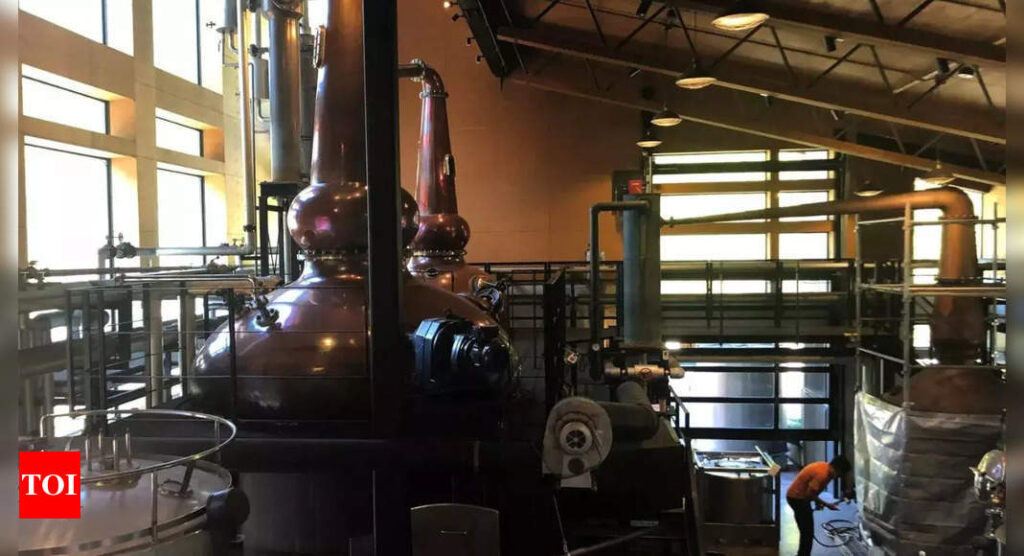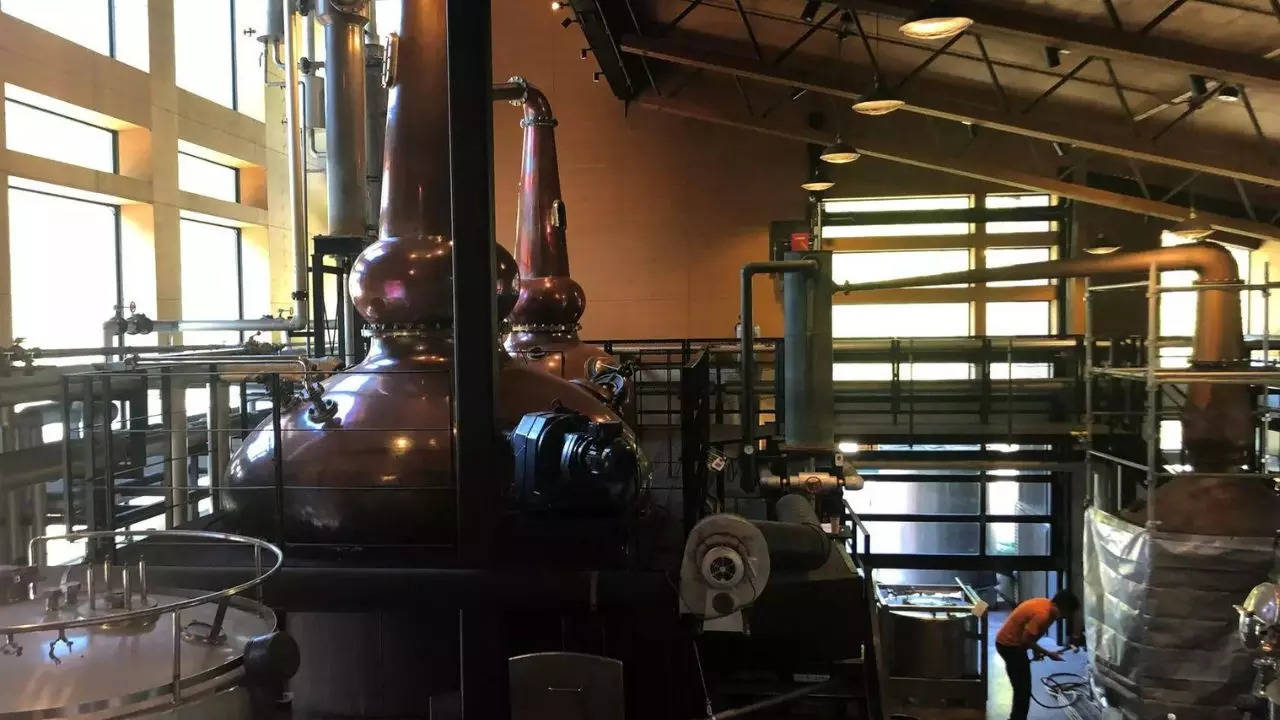[ad_1]
SHIZUOKA CITY: In a still fuelled by cedar from nearby forests, Shizuoka Distillery, a leader in Japan’s new wave of independent whisky makers, crafts its spirits to tap into surging global demand.
This year marks the 100 year anniversary of whisky making in Japan since the founding of market leader Suntory’s first distillery in Yamazaki in 1923.
And at the century mark, there are now more than 100 licensed distilleries in the country – twice as much as 10 years ago – with each one vying to make its mark in a rapidly expanding market.
The cedar fire – which Shizuoka claims is the world’s only wood fuelled blaze beneath a whisky still – is one of several novelties these distilleries are using to set themselves apart.
And even though their businesses are small compared to drinks giants like Suntory, their ambitions are world-class.
Taiko Nakamura, 54, was inspired to set up Shizuoka Distillery in 2016 by a trip to Scotland.
“I saw this distillery, and I was amazed that this tiny place in the mountainous countryside was selling whisky across the globe,” he said. “So I thought it would be fun to make my own whisky and then have people from all over the world enjoy it.”
The explosion of craft whisky in Japan follows a boom and bust in the industry.
Quality over quantity
Long viewed as an inferior copycat of Scotch, Japanese single malts and blended whiskies started racking up international awards around 2008, sparking intense global demand that effectively drank the supply dry by around 2015.
The shortage sent prices into the stratosphere. A set of 54 bottles from Ichiro’s Malt, a trailblazer in Japanese craft whisky, sold for $1.5 million in 2020 at a Hong Kong auction. Last week, Sotheby’s offered what it claimed was the most valuable collection of Japanese whisky at auction, headlined by a 52-year old bottle that sold for 300,000 pounds ($373,830).
Major makers Suntory and Nikka, a unit of beer maker Asahi Group, have spent the past decade ramping up capacity and stock of the spirit, which must age for at least three years to qualify as “Japanese whisky,” under 2021 standards.
Suntory, Japan’s biggest and best-known whisky maker, recently invested 10 billion yen ($67 million) to upgrade its distilleries, including its Yamazaki site.
Chief blender Shinji Fukuyo said he welcomes the new breed of Japanese distillers, and Suntory is willing to give advice to the startups “as long as it contributes to maintaining and improving the quality of Japanese whisky as a whole”.
Foreign money is flowing into the market too. In 2021, global drinks giant Diageo bought an undisclosed stake in Komasa Kanosuke Distillery, established in 2017 by a maker of traditional shochu liquor.
IJW Whiskey Company, a Kentucky-based company, set up a Japanese subsidiary known as Cedarfield that is building a distillery on the northern island of Hokkaido that would be Japan’s biggest, the Nikkei newspaper reported in March.
A Cedarfield representative declined to comment on the company’s plans.
But with new supply hitting the market and from so many new players, some in the industry have voiced concerns that poor quality product could spoil Japan’s reputation.
“That’s a real fear in the industry,” said Casey Wahl, an American expatriate who founded Kamui Whisky on the remote island of Rishiri in Japan’s extreme northern boundary.
Shizuoka’s Nakamura says makers like him can only respect the process and wait for the results.
“I believe we need to put all our effort into making Japanese whisky that lives up to the quality of the Japanese whiskies made by our predecessors,” he said.
This year marks the 100 year anniversary of whisky making in Japan since the founding of market leader Suntory’s first distillery in Yamazaki in 1923.
And at the century mark, there are now more than 100 licensed distilleries in the country – twice as much as 10 years ago – with each one vying to make its mark in a rapidly expanding market.
The cedar fire – which Shizuoka claims is the world’s only wood fuelled blaze beneath a whisky still – is one of several novelties these distilleries are using to set themselves apart.
And even though their businesses are small compared to drinks giants like Suntory, their ambitions are world-class.
Taiko Nakamura, 54, was inspired to set up Shizuoka Distillery in 2016 by a trip to Scotland.
“I saw this distillery, and I was amazed that this tiny place in the mountainous countryside was selling whisky across the globe,” he said. “So I thought it would be fun to make my own whisky and then have people from all over the world enjoy it.”
The explosion of craft whisky in Japan follows a boom and bust in the industry.
Quality over quantity
Long viewed as an inferior copycat of Scotch, Japanese single malts and blended whiskies started racking up international awards around 2008, sparking intense global demand that effectively drank the supply dry by around 2015.
The shortage sent prices into the stratosphere. A set of 54 bottles from Ichiro’s Malt, a trailblazer in Japanese craft whisky, sold for $1.5 million in 2020 at a Hong Kong auction. Last week, Sotheby’s offered what it claimed was the most valuable collection of Japanese whisky at auction, headlined by a 52-year old bottle that sold for 300,000 pounds ($373,830).
Major makers Suntory and Nikka, a unit of beer maker Asahi Group, have spent the past decade ramping up capacity and stock of the spirit, which must age for at least three years to qualify as “Japanese whisky,” under 2021 standards.
Suntory, Japan’s biggest and best-known whisky maker, recently invested 10 billion yen ($67 million) to upgrade its distilleries, including its Yamazaki site.
Chief blender Shinji Fukuyo said he welcomes the new breed of Japanese distillers, and Suntory is willing to give advice to the startups “as long as it contributes to maintaining and improving the quality of Japanese whisky as a whole”.
Foreign money is flowing into the market too. In 2021, global drinks giant Diageo bought an undisclosed stake in Komasa Kanosuke Distillery, established in 2017 by a maker of traditional shochu liquor.
IJW Whiskey Company, a Kentucky-based company, set up a Japanese subsidiary known as Cedarfield that is building a distillery on the northern island of Hokkaido that would be Japan’s biggest, the Nikkei newspaper reported in March.
A Cedarfield representative declined to comment on the company’s plans.
But with new supply hitting the market and from so many new players, some in the industry have voiced concerns that poor quality product could spoil Japan’s reputation.
“That’s a real fear in the industry,” said Casey Wahl, an American expatriate who founded Kamui Whisky on the remote island of Rishiri in Japan’s extreme northern boundary.
Shizuoka’s Nakamura says makers like him can only respect the process and wait for the results.
“I believe we need to put all our effort into making Japanese whisky that lives up to the quality of the Japanese whiskies made by our predecessors,” he said.
[ad_2]
Source link











More Stories
India’S Growth Forecast: S&P ups India’s FY’24 growth forecast to 6.4% on robust domestic momentum
India to remain fastest-growing major economy, but demand uneven: Poll
Jack Ma: Jack Ma gets back into business with ‘Ma’s Kitchen Food’